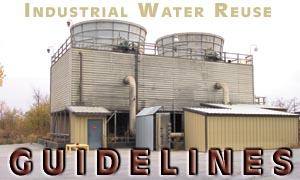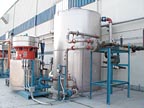
Water reuse in the industrial sector has increased substantially since the early 1990s for many of the same reasons urban reuse has gained popularity - water shortages and increased populations, particularly in drought areas, and legislation regarding water conservation and environmental compliance. To meet this increased demand, many states have increased the availability of reclaimed water to industries and have installed the necessary reclaimed water distribution lines. As a result, California, Arizona, Texas, Florida and Nevada have major industrial facilities using reclaimed water for cooling water and process/boiler-feed requirements. Utility power plants are ideal facilities for reuse due to their large water requirements for cooling, ash sluicing, rad waste dilution and flue gas scrubber requirements. Petroleum refineries, chemical plants and metal working facilities are among other industrial facilities benefiting from reclaimed water not only for cooling, but for process needs as well.

Keeping It Cool
For the majority of industries, cooling water is the largest use of reclaimed water because advancements in water treatment technologies have allowed industries to successfully use lesser quality waters. These advancements have enabled better control of deposits, corrosion and biological problems often associated with the use of reclaimed water in a concentrated cooling water system. There are two basic types of cooling water systems that use reclaimed water - once-through and recirculating evaporative. The recirculating evaporative cooling water system is the most common reclaimed water system due to its large water use and consumption by evaporation.As implied by the name, once-through cooling water systems involve a simple pass of cooling water through heat exchangers. There is no evaporation, and therefore, no consumption or concentration of the cooling water. Very few once-through cooling systems use reclaimed water and, in most instances, are confined to locations where reuse is convenient, such as where industries are located near an outfall. For example, Bethlehem Steel Co. in Baltimore has used 100 million gallons per day of treated wastewater effluent from Baltimore's Back River Wastewater Treatment Facility for processes and a once-through cooling water system since the early 1970s. The Rawhide Energy Station utility power plant in Fort Collins, Colo., has used about 245 million gallons per day of reclaimed water for once-through cooling of condensers since the 1980s. The reclaimed water is added to a body of water and the combined water is used in the once-through cooling system. After one-time use, the water is returned to the original water source (lake or river).
Recirculating evaporative cooling water systems use water to absorb process heat, and then transfer the heat by evaporation. As the cooling water is recirculated, makeup water is required to replace water lost through evaporation. Water must also be periodically removed from the cooling water system to prevent a buildup of dissolved solids in the cooling water. There are two common types of evaporative cooling systems that use reclaimed water - cooling towers and spray ponds.
Cooling Tower Systems
Like all recirculating evaporative systems, cooling water towers are designed to take advantage of the absorption and transfer of heat through evaporation. Over the past decade, cooling towers have increased in efficiency so that only 1.75 percent of the recirculated water is evaporated for every 10 degrees F drop in process water heat, decreasing the need to supplement with makeup water. Because water is evaporated, the dissolved solids and minerals will remain in the recirculated water. These solids must be removed or treated to prevent accumulation on the cooling equipment as well as the cooling tower. This removal is accomplished by discharging a portion of the cooling water, referred to as blow-down water. The blow-down water usually is treated by a chemical process and/or a filtration/softening/clarification process before disposal. Buildup of total dissolved solids can occur within the reclamation/industrial cooling system if the blow-down waste stream, with increased dissolved solids, is recirculated between the water reclamation plant and the cooling system.The Curtis Stanton Energy Facility in Orlando, Fla., receives reclaimed water from a wastewater facility for cooling water. Initially, the blow-down water was planned to be returned to the wastewater facility. However, this process eventually would increase the concentration of dissolved solids in the reclaimed water to a degree that it could not be used as cooling water in the future. So, as an alternative, the blow-down water is crystallized at the Curtis Stanton facility and disposed of at a landfill.
The City of San Marcos, Texas, identified the following indirect impacts associated with receiving the blow-down water back at their wastewater treatment plant:
- reduced treatment capacity;
- impact to the biological process;
- impact to the plant effluent-receiving stream.
To avoid the impacts to the wastewater treatment plant, the city installed a dedicated line to return the blow-down water directly to the UV disinfection chamber. Therefore, there was no loss of plant capacity or impact to the biological process. The city has provided increased monitoring of the effluent-receiving stream to identify any potential stream impacts.
Cooling tower designs vary widely. Large hyperbolic concrete structures range from 250 feet to 400 feet tall and 150 feet to 200 feet in diameter, and are common at utility power plants. These cooling towers can recirculate approximately 200,000 gpm to 500,000 gpm of water and evaporate approximately 6,000 gpm to 15,000 gpm of water.
Smaller cooling towers can be rectangular boxes constructed of wood, concrete, plastic and/or fiberglass-reinforced plastic with circular fan housings for each cell. Each cell can recirculate (cool) approximately 3,000 gpm to 5,000 gpm. Petroleum refineries, chemical plants, steel mills, smaller utility plants and other processing industries can have as many as 15 cells in a single cooling tower, recirculating approximately 75,000 gpm. Commercial air-conditioning cooling tower systems can recirculate as little as 100 gpm to as much as 40,000 gpm.
Spray Ponds
Spray ponds usually are small lakes or bodies of water where warmed cooling water is directed to nozzles that spray upward to mix with air. This spraying causes evaporation, but usually only produces a 3 degree F to 8 degree F drop in temperature. Spray ponds often are used by facilities, such as utility power plants, where minimal cooling is needed and where the pond also can be incorporated into either decorative fountains or the air conditioning system. Reclaimed water has some application related to spray ponds, usually as makeup water, since there often are restrictions on discharging reclaimed water into lakes or ponds. In addition, there is a potential for foaming within the spray pond if only reclaimed water is used. For example, the City of Fort Collins, Colo., supplies reclaimed water to the Platte River Power Authority for cooling its 250 megawatt Rawhide Energy Station. The recirculation cooling system is a 5.2-billion-gallon lake used to supply 170,000 gpm to the condenser and auxiliary heat exchangers. Reclaimed water is treated to reduce phosphate and other contaminants, and then added to the freshwater lake.
The most frequent water quality problems in cooling water systems are corrosion, biological growth and scaling. These problems arise from contaminants in potable water as well as in reclaimed water, but the concentrations of some contaminants in reclaimed water may be higher than in potable water.
Boiler Make-up Water
The use of reclaimed water for boiler make-up water differs little from the use of conventional public water supply; both require extensive additional treatment. Quality requirements for boiler make-up water depend on the pressure at which the boiler is operated. Generally, the higher the pressure, the higher the quality of water required. Very high pressure (1,500 psi and above) bboilers require make-up water of very high quality.In general, both potable water and reclaimed water used for boiler water make-up must be treated to reduce the hardness of the boiler feed water to close to zero. Removal or control of insoluble scales of calcium and magnesium, and control of silica and alumina, are required since these are the principal causes of scale buildup in boilers. Depending on the characteristics of the reclaimed water, lime treatment (including flocculation, sedimentation and recarbonation) might be followed by multi-media filtration, carbon adsorption and nitrogen removal. High-purity boiler feed water for high-pressure boilers also might require treatment by reverse osmosis or ion exchange. High alkalinity may contribute to foaming, resulting in deposits in the superheater, reheater or turbines. Bicarbonate alkalinity, under the influence of boiler heat, may lead to the release of carbon dioxide, which is a source of corrosion in steam-using equipment. The considerable treatment and relatively small amounts of makeup water required normally make boiler make-up water a poor candidate for reclaimed water.
Since mid-2000, several refineries located in Los Angeles have used reclaimed water as their primary source of boiler make-up water. Through the use of clarification, filtration and reverse osmosis, high-quality boiler make-up water is produced that provides freshwater, chemical and energy savings.
Industrial Process Water
The suitability of reclaimed water for use in industrial processes depends on the particular use. For example, the electronics industry requires water of almost distilled quality for washing circuit boards and other electronic components. On the other hand, the tanning industry can use relatively low-quality water. Requirements for textiles, pulp and paper, and metal fabricating are intermediate. Thus, in investigating the feasibility of industrial reuse with reclaimed water, potential users must be contacted to determine the specific requirements for their process water.ND
Report Abusive Comment